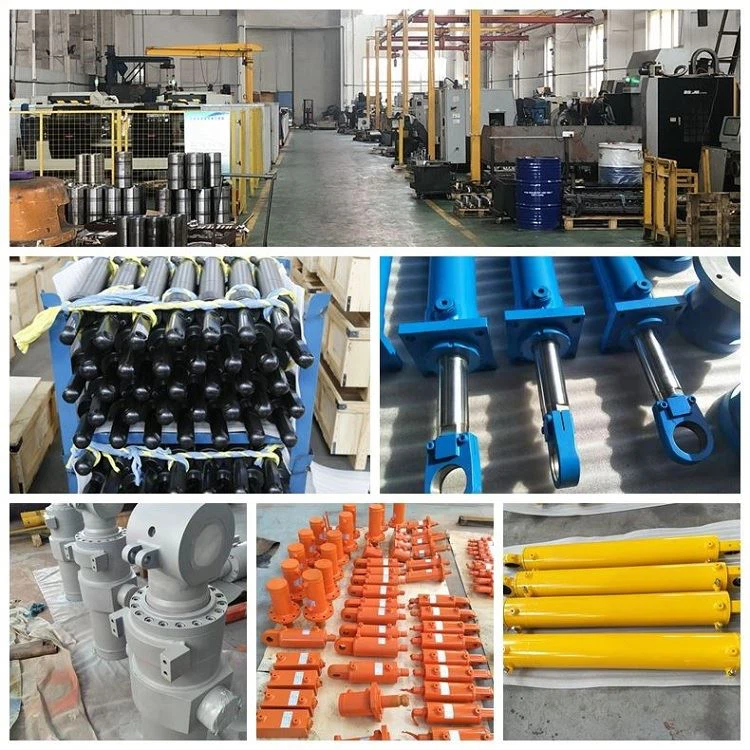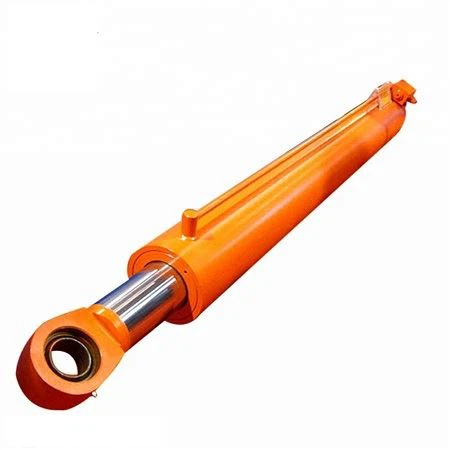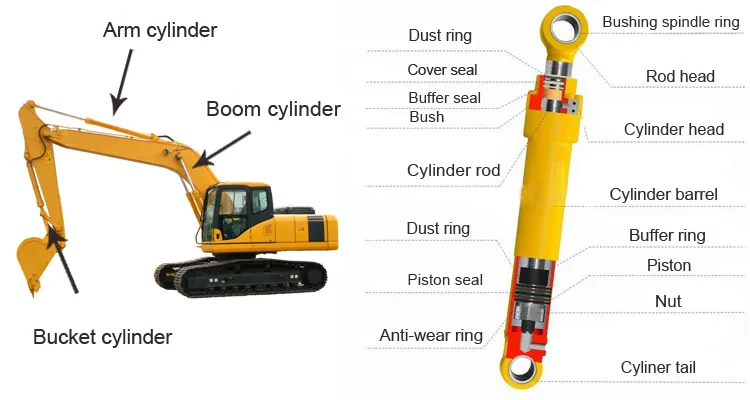Product Description
| Excavator Hydraulic Cylinder Arm Boom Bucket Cylinder For famous brand excavator | |||
| Part number | Tube dia mm | Rod dia mm | Stroke mm |
| 205-63-57100 | 120 | 85 | 1285 |
| 206-63-57100 | 120 | 85 | 1285 |
| 205-63-57160 | 120 | 85 | 1285 |
| 205-63-57120 | 135 | 95 | 1490 |
| 203-63-57130 | 125 | 85 | 1120 |
| 203-63-57131 | 125 | 85 | 1120 |
| 205-63-57130 | 125 | 85 | 1120 |
Specifications
1.Supply to USA,Europe,and Australia, Russia.
2.Material:Stainless Steel
3.Professional performance excavator parts supplier
4. High quality and low price
FAQ
Q1: Are you Manufacture or Trade Company?
A1: We are manufacture,we have 20 years experience for supply Metal material and products in domestic.
Q2: How can we guarantee quality?
A2: Always a pre-production sample before mass production;Always final Inspection before shipment;
Q3: What is your terms of payment ?
A3: 1.T/T: 30% deposit in advance, the balance 70% paid before shipment
2.30% down payment, the balance 70% paid against L/C at sight
3.CHINAMFG negotiation
Q4: Can you provide Certificates for aluminum materials ?
A4:Yes,we can supply MTC-Material Test Certificate.
Q5: Can you provide sample?
A5: Yes, we can provide you sample, but you need to pay for the sample and freight firstly. We will return the sample fee after
you make an order.
| Certification: | GS, RoHS, CE, ISO9001 |
|---|---|
| Pressure: | Medium Pressure |
| Work Temperature: | Normal Temperature |
| Acting Way: | Double Acting |
| Working Method: | Piston Cylinder |
| Adjusted Form: | Switching Type |
| Customization: |
Available
|
|
|---|

How does a boom cylinder handle variations in load capacity and weight?
A boom cylinder is designed to handle variations in load capacity and weight in heavy machinery. Here’s a detailed explanation:
When a machinery equipped with a boom cylinder is used for different tasks, the load capacity and weight requirements may vary. The boom cylinder is designed to accommodate these variations and ensure optimal performance. Here are the key factors that contribute to how a boom cylinder handles load capacity and weight variations:
- Force Generation: The boom cylinder generates the necessary force to move the boom, arm, or attachment of the machinery. The force generated by the cylinder can be adjusted based on the load capacity and weight requirements. By controlling the hydraulic pressure and flow rate, the operator can regulate the force exerted by the cylinder, allowing it to handle both lighter and heavier loads.
- Adjustable Stroke Length: Boom cylinders often have an adjustable stroke length, which is the distance the piston can travel within the cylinder. By adjusting the stroke length, the cylinder can adapt to different load capacities and weight distributions. For heavier loads, a longer stroke may be required to provide the necessary extension or retraction of the boom. Conversely, for lighter loads, a shorter stroke may be sufficient, optimizing the cylinder’s efficiency.
- Pressure Compensation: Some boom cylinders are equipped with pressure compensation mechanisms. These mechanisms automatically adjust the hydraulic pressure within the cylinder to compensate for variations in load capacity and weight. For example, as the load on the boom increases, the pressure compensation mechanism increases the hydraulic pressure, ensuring consistent force and control throughout the operation.
- Integration with Load Sensing Systems: Boom cylinders can be integrated with load sensing systems that provide real-time feedback on the load capacity and weight. Load sensing systems use sensors to measure the force exerted on the boom or attachment and transmit this information to the hydraulic control system. The hydraulic control system can then adjust the pressure and flow rate to match the load requirements, optimizing the cylinder’s performance.
- Multi-Stage Cylinders: In some cases, machinery may be equipped with multi-stage boom cylinders. These cylinders have multiple sections or stages that can be extended or retracted independently. Each stage may have different dimensions and force capabilities. By adjusting the extension or retraction of each stage, the cylinder can adapt to varying load capacities and weight distributions, providing precise control and handling.
By incorporating these design features and mechanisms, a boom cylinder can effectively handle variations in load capacity and weight. This allows the machinery to perform a wide range of tasks with different load requirements, providing versatility and efficiency in industries such as construction, mining, material handling, and more.

How does a boom cylinder handle variations in cylinder mounting and orientation?
A boom cylinder is designed to handle variations in cylinder mounting and orientation. Here’s a detailed explanation:
In different applications, such as construction equipment, material handling machinery, or hydraulic systems, boom cylinders may need to accommodate variations in cylinder mounting and orientation. The design and features of a boom cylinder allow it to adapt to these variations and function effectively. Here’s how a boom cylinder handles variations in cylinder mounting and orientation:
- Flexible Mounting Options: Boom cylinders are designed with flexible mounting options to accommodate different equipment configurations. They can be mounted in various orientations, such as vertically, horizontally, or at an angle, depending on the specific requirements of the application. The cylinder’s mounting flexibility allows for easy integration into different systems and ensures proper alignment and connection between the boom and the equipment.
- Articulating Capability: Boom cylinders often have articulating capability, which enables them to handle variations in cylinder orientation. The cylinder may have multiple pivot points or joints, allowing it to articulate and adjust its angle or position relative to the boom or equipment. This articulation capability ensures that the cylinder can adapt to different mounting angles and orientations, providing optimal performance and load control.
- Rotational Movement: Some boom cylinders are designed to handle rotational movement. They can rotate or swivel around their mounting points, allowing them to accommodate variations in cylinder orientation. This rotational movement ensures that the cylinder can align with the desired direction of force or movement, regardless of the mounting angle or orientation.
- Flexible Hydraulic Connections: Boom cylinders have flexible hydraulic connections to accommodate variations in cylinder mounting and orientation. The hydraulic hoses or fittings are designed to be adjustable or swivel, allowing for easy connection to the hydraulic system of the equipment. This flexibility ensures that the hydraulic fluid can flow smoothly and reach the cylinder, regardless of its mounting position or orientation.
The ability of a boom cylinder to handle variations in cylinder mounting and orientation offers several benefits:
- Versatility: Boom cylinders can be used in a wide range of equipment configurations and applications, providing versatility and adaptability.
- Optimal Performance: The flexibility in mounting and orientation allows boom cylinders to achieve optimal performance and load control in different working conditions.
- Easy Integration: The flexible mounting options and hydraulic connections simplify the integration of boom cylinders into various systems, reducing installation time and effort.
- Improved Efficiency: Boom cylinders that can handle variations in mounting and orientation contribute to efficient operation, as they can be adjusted to suit specific requirements and constraints.
Overall, a boom cylinder is designed to handle variations in cylinder mounting and orientation. It offers flexible mounting options, articulating capability, rotational movement, and adaptable hydraulic connections. These features enable the cylinder to accommodate different equipment configurations, orientations, and working conditions, ensuring optimal performance and load handling.
It’s important to consult the manufacturer’s guidelines and specifications for the boom cylinder to ensure proper installation, alignment, and operation in accordance with the specific equipment and application requirements.

How does a boom cylinder differ from other types of hydraulic cylinders?
A boom cylinder differs from other types of hydraulic cylinders in terms of its design, function, and application. Here’s a detailed explanation of the differences:
- Design: Boom cylinders are specifically designed for heavy machinery, such as excavators, cranes, and loaders, where they are used to control the movement of the boom. They are typically larger and more robust compared to other hydraulic cylinders to handle heavy loads and withstand harsh operating conditions.
- Function: The primary function of a boom cylinder is to extend, retract, lift, and lower the boom of heavy machinery. It provides the necessary force and control to maneuver the boom for tasks such as excavation, material handling, or lifting heavy loads. Other types of hydraulic cylinders, such as single-acting or double-acting cylinders, may serve different purposes, such as linear motion control or actuation of specific machine components.
- Application: Boom cylinders are predominantly used in heavy machinery applications where the boom’s movement is critical, such as construction, mining, and material handling. They are specifically designed to meet the requirements of these industries, including the ability to handle high loads, repetitive movements, and extreme operating conditions. Other hydraulic cylinders, on the other hand, have a wide range of applications across various industries, including manufacturing, agriculture, automotive, and aerospace.
- Size and Capacity: Boom cylinders are typically larger in size and have higher load capacities compared to other hydraulic cylinders. This is because they need to accommodate the size and weight of the boom and handle the significant forces involved in heavy machinery operations. Other types of hydraulic cylinders come in various sizes and load capacities, depending on their specific application and requirements.
- Integration: Boom cylinders are often integrated into the hydraulic systems and control mechanisms of heavy machinery. They work in conjunction with other hydraulic components, such as pumps, valves, and actuators, to ensure synchronized and precise boom movements. Other hydraulic cylinders may also be integrated into different systems, but their integration and functionality may vary depending on the specific application.
In summary, a boom cylinder differs from other types of hydraulic cylinders in terms of design, function, application, size, capacity, and integration. Its specialized design and function make it suitable for controlling the movement of the boom in heavy machinery, providing the necessary force, control, and durability required for demanding applications in construction, mining, and material handling industries.


editor by CX 2023-11-28